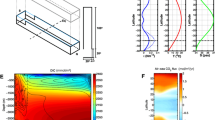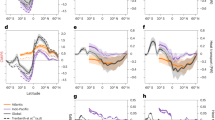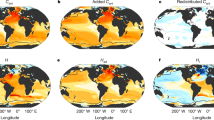Abstract
We analyse the impact of migration and strength of Southern Hemisphere westerly winds on the ocean carbon cycle in a systematic sensitivity study with the University of Victoria Earth System Climate Model. We find that changes in the biological pump are mainly driven by changes in ocean residence times while changes in export production are negligible. Changes in the biological and physical pumps are always of opposite sign; with the physical pump being dominant for southward shifts and the biological pump being dominant for northward shifts. Furthermore, changes in the Pacific Ocean carbon budget dictate the overall changes in global marine and atmospheric carbon. Overall, atmospheric \(\hbox {CO}_2\) increases (and \(\Delta ^{14}\hbox {C}\) decreases) for northward shifts or a strengthening in wind forcing. The opposite is true for a southward shift or a weakening in wind forcing. Combining forcings (shift and intensity change) results in a combination of their impacts with the direction of the shift being the first order forcing. The terrestrial carbon reservoir absorbs (releases) 50–70 % of the net oceanic carbon loss (increase), counterbalancing the effect on atmospheric \(\hbox {CO}_2\).













Similar content being viewed by others
References
Archer D (1996) A data-driven model of the global calcite lysocline. Global Biogeochem Cycles 10(3):511–526
Berger AL (1978) Long-term variations of daily insolation and quaternary climatic changes. J Atmos Sci 35:2362–2367
Biastoch A, Böning CW, Schwarzkopf FU, Lutjeharms JRE (2009) Increase in Agulhas leakage due to poleward shift of Southern Hemisphere westerlies. Nature 462:495–498. doi:10.1038/nature08519
Bryan K, Lewis LJ (1979) A water mass model of the World Ocean. J Geophys Res Oceans 84(C5):2503–2517. doi:10.1029/JC084iC05p02503
Chen G, Millero FJ (1979) Gradual increase of oceanic CO\(_2\). Nature 277:205–206
Delworth TL, Zeng F (2008) Simulated impact of altered Southern Hemisphere winds on the Atlantic meridional overturning circulation. Geophys Res Lett 35(20). doi:10.1029/2008GL035166
d’Orgeville M, Sijp WP, England MH, Meissner KJ (2010) On the control of glacial-interglacial atmospheric CO\(_2\) variations by the Southern Hemisphere westerlies. Geophys Res Lett 37(21):1–5
Doval M, Hansell DA (2000) Organic carbon and apparent oxygen utilization in the western South Pacific and the central Indian Oceans. Mar Chem 68(3):249–264. doi:10.1016/S0304-4203(99)00081-X. http://www.sciencedirect.com/science/article/pii/S03044203990 0081X
Eby M, Zickfeld K, Montenegro A, Archer D, Meissner KJ, Weaver AJ (2009) Lifetime of anthropogenic climate change: millennial time-scales of potential CO\(_2\) and surface temperature perturbations. J Clim 22:2501–2511. doi:10.1175/2008JCLI2554.1
Gent P, McWilliams J (1990) Isopycnal mixing in ocean circulation models. J Phys Oceanogr 20:150–155
Hibler III WD (1979) A dynamic thermodynamic sea ice model. J. Phys. Oceanogr. 9(4):815–846. http://journals.ametsoc.org/doi/abs/10.1175/1520-0485(1979)00%9%3C0815%3AADTSIM%3E2.0.CO%3B2
Huiskamp WN, Meissner KJ (2012) Oceanic carbon and water masses during the mystery interval: A model-data comparison study. Paleoceanography 27:PA4206. doi:10.1029/2012PA002368
Hunke EC, Dukowicz JK (1997) An elastic-viscous-plastic model for sea ice dynamics. J Phys Oceanogr 27(9):1849–1867
Ito T, Follows M (2005) Preformed phosphate, soft tissue pump and atmospheric CO\(_2\). J Mar Res 63:813–839. doi:10.1357/0022240054663231
Kalnay E, Kanamitsu M, Kistler R, Collins W, Deaven D, Gandin L, Iredell M, Saha S, White G, Woollen J, Zhu Y, Chelliah M, Ebisuzaki W, Higgins W, Janowiak J, Mo KC, Ropelewski C, Wang J, Leetma A, Reynolds R, Jenne R, Joseph D (1996) The NCEP/NCAR 40-year reanalysis project. Bull Am Meteorol Soc 77(3):437–471
Lauderdale JM, Garabato ACN, Oliver KI, Follows MJ, Williams RG (2013) Wind-driven changes in Southern Ocean residual circulation, ocean carbon reservoirs and atmospheric CO\(_2\). Clim Dyn 41(7–8):2145–2164. doi:10.1007/s00382-012-1650-3
Lee S, Feldstein SB (2013) Detecting ozone- and greenhouse gas-driven wind trends with observational data. Science 339(6119):563–567. doi:10.1126/science.1225154. http://www.sciencemag.org/content/339/6119/563.full.pdf
Lovenduski NS, Ito T (2009) The future evolution of the Southern Ocean CO\(_2\) sink. J Mar Res 67(5):597–617. doi:10.1357/002224009791218832
Lovenduski NS, Gruber N, Doney SC, Lima ID (2007) Enhanced CO\(_2\) outgassing in the Southern Ocean from a positive phase of the Southern Annular Mode. Global Biogeochem Cycles 21(2): gB2026. doi:10.1029/2006GB002900
Marinov I, Gnanadesikan A, Toggweiler JR, Sarmiento JL (2006) The Southern Ocean biogeochemical divide. Nature 441:964–967. doi:10.1038/nature04883
Marshall J, Speer K (2012) Closure of the meridional overturning circulation through Southern Ocean upwelling. Nat Geosci 5(3):171–180
McDermott DA (1996) The regulation of northern overturning by Southern Hemisphere winds. J Phys Oceanogr 26(7):1234–1255. doi:10.1175/1520-0485(1996)026<1234:TRONOB>2.0.CO;2
Meissner K, Weaver A, Matthews H, Cox P (2003a) The role of land surface dynamics in glacial inception: a study with the UVic earth system model. Clim Dyn 21(7–8):515–537. doi:10.1007/s00382-003-0352-2
Meissner KJ (2007) The Younger Dryas: a data to model comparison to constrain the strength of the overturning circulation. Geophys Res Lett 34(L21):705
Meissner KJ, Schmittner A, Weaver AJ, Adkins JF (2003b) Ventilation of the North Atlantic Ocean during the Last Glacial Maximum: a comparison between simulated and observed radiocarbon ages. Paleoceanography 18(2). doi:10.1029/2002PA000762
Meissner KJ, McNeil BI, Eby M, Wiebe EC (2012) The importance of the terrestrial weathering feedback for multimillennial coral reef habitat recovery. Global Biogeochem Cycles 26(3):GB3017. doi:10.1029/2011GB004098
Menviel L, Timmermann A, Mouchet A, Timm O (2008) Climate and marine carbon cycle response to changes in the strength of the Southern Hemispheric westerlies. Paleoceanography 23(4). doi:10.1029/2008PA001604
Menviel L, England MH, Meissner KJ, Mouchet A, Yu J (2014) Atlantic-Pacific seesaw and its role in outgassing CO\(_2\) during Heinrich events. Paleoceanography 29(1):58–70. doi:10.1002/2013PA002542
Munday DR, Johnson HL, Marshall DP (2014) Impacts and effects of mesoscale ocean eddies on ocean carbon storage and atmospheric pCO\(_2\). Global Biogeochem Cycles 28(8):877–896. doi:10.1002/2014GB004836
Pacanowski RC (1995) MOM 2 documentation, user’s guide and reference manual. In: Technical Report 3, GFDL Ocean Group, Geophysical Fluid Dynamics Laboratory, Princeton, USA
Previdi M, Polvani LM (2014) Climate system response to stratospheric ozone depletion and recovery. Q J R Meteorol Soc. doi:10.1002/qj.2330
Rahmstorf S, England MH (1997) Influence of Southern Hemisphere winds on North Atlantic deep water flow. J Phys Oceanogr 27(9):2040–2054
Russell JL, Dixon KW, Gnanadesikan A, Stouffer RJ, Toggweiler JR (2006) The southern hemisphere westerlies in a warming world: propping open the door to the deep ocean. J Clim 19(24):6382–6390. doi:10.1175/JCLI3984.1
Saenko OA, Weaver AJ, Schmittner A (2003) Atlantic deep circulation controlled by freshening in the Southern Ocean. Geophys Res Lett 30(14). doi:10.1029/2003GL017681
Sarmiento JL, Gruber N, Brzezinski MA, Dunne JP (2004) High-latitude controls of thermocline nutrients and low latitude biological productivity. Nature 427:56–60. doi:10.1038/nature02127
Sasse TP, McNeil BI, Abramowitz G (2013) A new constraint on global air–sea CO\(_2\) fluxes using bottle carbon data. Geophys Res Lett 40(8):1594–1599. doi:10.1002/grl.50342
Schartau M, Oschlies A (2003) Simultaneous data-based optimization of a 1D-ecosystem model at three locations in the North Atlantic Ocean: Part 2. Standing stocks and nitrogen fluxes. J Mar Res 61(6):795–821
Schmittner A, Oschlies A, Matthews HD, Galbraith ED (2008) Future changes in climate, ocean circulation, ecosystems, and biogeochemical cycling simulated for a business-as-usual CO\(_2\) emission scenario until year 4000 AD. Global Biogeochem Cycles 22(1):GB1013
Schmittner A, Gruber N, Mix AC, Key RM, Tagliabue A, Westberry TK (2013) Biology and air–sea gas exchange controls on the distribution of carbon isotope ratios (\(\delta ^{13}{\text{ C }}\)) in the ocean. Biogeosciences 10:5793–5816. doi:10.5194/bg-10-5793-2013
Semtner AJJ (1976) A model for the thermodynamic growth of sea ice in numerical investigations of climate. J Phys Oceanogr 6(3):379–389
Sijp WP, England MH (2008) The effect of a northward shift in the southern hemisphere westerlies on the global ocean. Prog Oceanogr 79:1–19
Sijp WP, England MH (2009) Southern hemisphere westerly wind control over the ocean’s thermohaline circulation. J Clim 22(5):1277–1286
Skinner LC, Fallon S, Waelbroeck C, Michel E, Barker S (2010) Ventilation of the deep Southern Ocean and deglacial CO\(_2\) rise. Science 328(5982):1147–1151
Son SW, Polvani LM, Waugh DW, Akiyoshi H, Garcia R, Kinnison D, Pawson S, Rozanov E, Shepherd TG, Shibata K (2008) The impact of stratospheric ozone recovery on the southern hemisphere westerly jet. Science 320(5882):1486–1489. doi:10.1126/science.1155939. http://www.sciencemag.org/content/320/5882/1486.full.pdf
Stuiver M, Polach HA (1977) Discussion: reporting of 14C data. Radiocarbon 19(3):355–363. http://www.radiocarbon.org/Pubs/Stuiver/Stuiver-Polach.pdf
Swart NC, Fyfe JC, Saenko OA, Eby M (2014) Wind-driven changes in the ocean carbon sink. Biogeosciences 11(21):6107–6117. doi:10.5194/bg-11-6107-2014. http://www.biogeosciences.net/11/6107/2014/
Takahashi T, Sweeney C, Hales B, Chipman D, Newberger T, Goddard J, Iannuzzi R, Sutherland S (2012) The changing carbon cycle in the Southern Ocean. Oceanography 25(3):26–37. doi:10.5670/oceanog.2012.71
Toggweiler J, Samuels B (1995) Effect of Drake passage on the global thermohaline circulation. Deep Sea Res Part I Oceanogr Res Pap 42(4):477–500. doi:10.1016/0967-0637(95)00012-U. http://www.sciencedirect.com/science/article/pii/096706379500
Toggweiler JR, Russell JL, Carson SR (2006) Midlatitude westerlies, atmospheric CO\(_2\), and climate change during the ice ages. Paleoceanography 21(2):PA001,154
Tschumi T, Joos F, Parekh P (2008) How important are Southern Hemisphere wind changes for low glacial carbon dioxide? A model study. Paleoceanography 23(4). doi:10.1029/2008PA001592
Völker C, Köhler P (2013) Responses of ocean circulation and carbon cycle to changes in the position of the Southern Hemisphere westerlies at Last Glacial Maximum. Paleoceanography 28(4):726–739. doi:10.1002/2013PA002556
Weaver A, Hughes TMC (1992) Stability and variability of the thermohaline circulation and its link to climate. In: Jacob A (ed) Trends in physical oceanography. Research Trends Series, vol 1. Council of Scientific Research Integration, Trivandrum, India, pp 15–70
Weaver AJ, Eby M, Wiebe EC, Bitz CM, Duffy PB, Ewen TL, Fanning AF, Holland MM, MacFadyen A, Matthews HD, Meissner KJ, Saenko O, Schmittner A, Wang H, Yoshimori M (2001) The UVic earth system climate model: model description, climatology, and applications to past, present and future climates. Atmos Ocean 4:361–428
Zickfeld K, Fyfe JC, Saenko OA, Eby M, Weaver AJ (2007) Response of the global carbon cycle to human-induced changes in southern hemisphere winds. Geophys Res Lett 34(12). doi:10.1029/2006GL028797
Acknowledgments
The authors would like to thank Matthew England, Chris Turney and Paul Valdes for comments on earlier drafts of this manuscript. The work was supported by the Australian Research Council (FT100100443, DP130104156). KJM is grateful for an award under the Merit Allocation Scheme on the NCI National Facility at the ANU. The authors declare that they have no conflict of interest.
Author information
Authors and Affiliations
Corresponding author
Rights and permissions
About this article
Cite this article
Huiskamp, W.N., Meissner, K.J. & d’Orgeville, M. Competition between ocean carbon pumps in simulations with varying Southern Hemisphere westerly wind forcing. Clim Dyn 46, 3463–3480 (2016). https://doi.org/10.1007/s00382-015-2781-0
Received:
Accepted:
Published:
Issue Date:
DOI: https://doi.org/10.1007/s00382-015-2781-0




